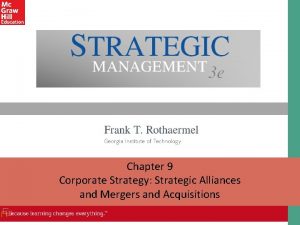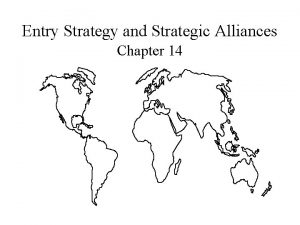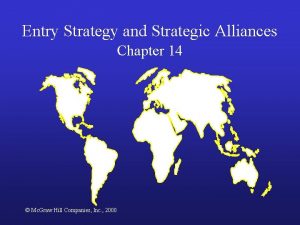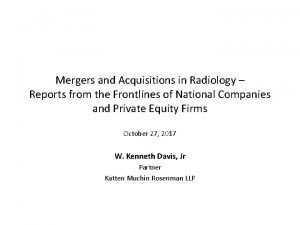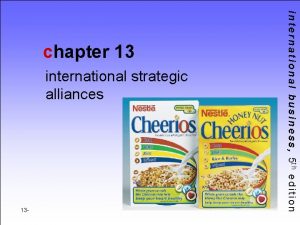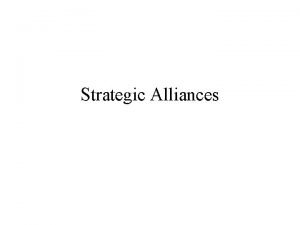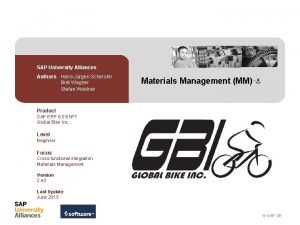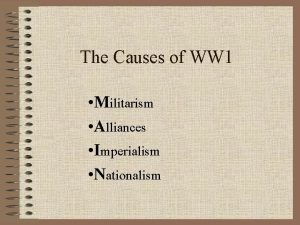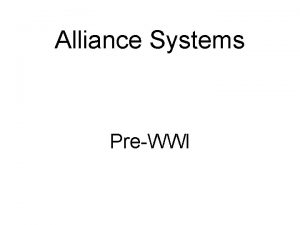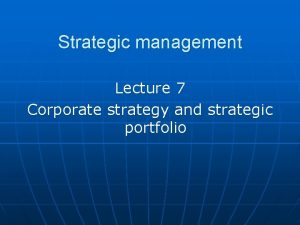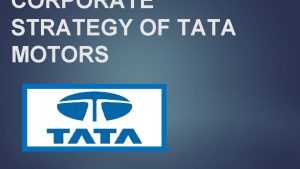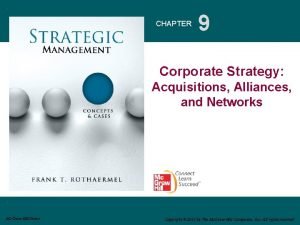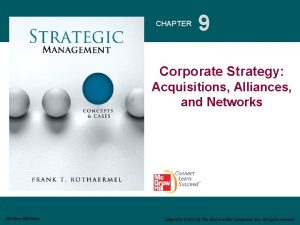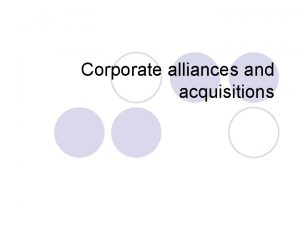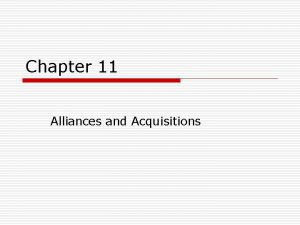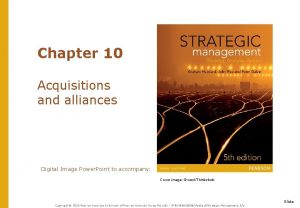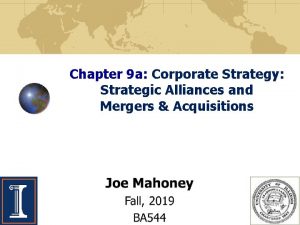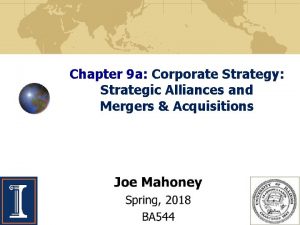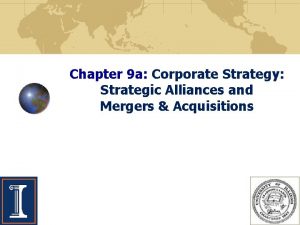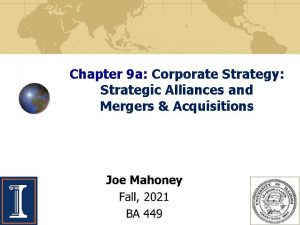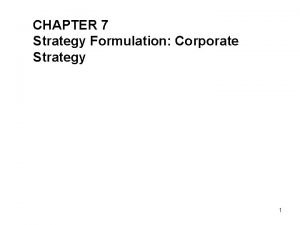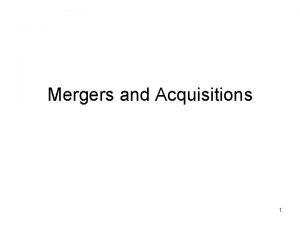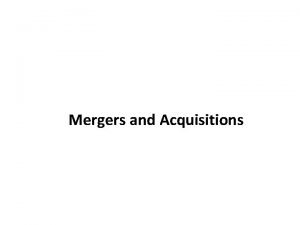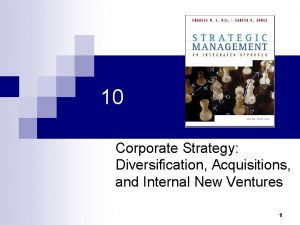CHAPTER 9 Corporate Strategy Acquisitions Alliances and Networks












































- Slides: 44

CHAPTER 9 Corporate Strategy: Acquisitions, Alliances, and Networks Mc. Graw-Hill/Irwin Copyright © 2013 by The Mc. Graw-Hill Companies, Inc. All rights reserved.

Part 2 Strategy Formulation

LO 9 -1 Differentiate between mergers and acquisitions, and explain why firms would use either as a vehicle for corporate strategy. LO 9 -2 Define horizontal integration and evaluate the advantages and disadvantages of this corporate level strategy. LO 9 -3 Evaluate whether mergers and acquisitions lead to competitive advantage. LO 9 -4 Define strategic alliances, and explain why they are important corporate strategy vehicles and why firms enter into them. LO 9 -5 Describe three alliance governance mechanisms and evaluate their pros and cons. LO 9 -6 Describe three phases of alliance management, and explain how an alliance management capability can lead to a competitive advantage. LO 9 -7 Define strategic networks and evaluate the advantages and disadvantages of different network positions.

Chapter Case 9 Facebook: From Dorm Room to Dominant Social Network • Facebook: “most powerful and transformative social change” Ø Started by Mark Zuckerberg in 2004 Ø Overcame the first-mover advantage held by My. Space Ø True global strategy: more users first, profits later Ø Adding different functions to go after a wide range of users Ø Innovative network marketing approach v Word of mouth through online social network • Frequently attacked for insufficient protection of users’ privacy • Needs a sustainable business model

Chapter Case 9 Facebook: From Dorm Room to Dominant Social Network • Facebook: business model Ø Drive volume (& not profits) Ø Attract top software developers for apps • What are the key issues in the opening case? • New strategic intent: Maximize the benefits from network effects v Online v Winner marketing takes all Ø Implications for alliances and networks

EXHIBIT 9. 1 Global Users of Facebook and My. Space Facebook passes My. Space on number of users in 2008 and continues exponential growth

Integrating Companies: Mergers and Acquisitions • Merger: combining two companies Ø Friendly approach v Ex: Disney & Pixar Ø Generally similar in size • Acquisition: purchase or takeover a company Ø Can be friendly or unfriendly Ø Hostile takeover v Ex: Vodafone buys Mannesmann Dell Makeover Video

Horizontal Integration: Merging with Competitors • Horizontal integration: process of merging and acquiring competitors Ø HP buys Compaq in 2002 Ø Pfizer buys Wyeth in 2009 Ø Live Nation buys Ticketmaster in 2010 • Benefits: Ø Reduce competitive intensity Ø Lower costs Ø Boost differentiation Ø Access to new markets and distribution channels

EXHIBIT 9. 2 Source of Value Creation and Costs in Horizontal Integration Benefits Drawbacks

Reduction in Competitive Intensity • Changes underlying industry structure Ø Taking out excessive capacity from rivals Ø Increased industry consolidation v Example: U. S. airlines in recent years • Increasing bargaining power vis-à-vis suppliers and buyers • Stable industry and more profits • Usually need government’s approval Ø Example: FTC rejected Office Depot & Staples merger

Horizontal Integration: Lower Costs • How? Ø Through economies of scale Ø Enhancing economic value creation • Crucial to the industries with high fixed costs Ø Example: pharmaceutical industry Ø Large sales force = fixed cost v Need $1 billion in drug revenues to cover these costs

STRATEGY HIGHLIGHT 9. 1 Food Fight: Kraft Hostile Takeover of Cadbury • Kraft acquired Cadbury in UK Ø Hostile takeover, $20 billion deal Ø Cadbury has strong position in emerging economies v Perfected distribution system in countries like India Ø Kraft faces strong rivalries worldwide, including China • The acquisition forces Hershey and other competitors to rethink their strategies Ø Hershey 90% revenues from U. S. market 1– 12

Horizontal Integration • Increased differentiation Ø Strengthen competitive positions v Differentiation of products and services – Example: Oracle buys People. Soft ($10 B in 2005) • Joined enterprise software with HR management software • Access to new markets and distribution channel Ø Enter new markets by M&A – Ex: Kraft buys Cadbury • New distribution in emerging markets & domestically

LO 9 -1 Differentiate between mergers and acquisitions, and explain why firms would use either as a vehicle for corporate strategy. LO 9 -2 Define horizontal integration and evaluate the advantages and disadvantages of this corporate level strategy. LO 9 -3 Evaluate whether mergers and acquisitions lead to competitive advantage. LO 9 -4 Define strategic alliances, and explain why they are important corporate strategy vehicles and why firms enter into them. LO 9 -5 Describe three alliance governance mechanisms and evaluate their pros and cons. LO 9 -6 Describe three phases of alliance management, and explain how an alliance management capability can lead to a competitive advantage. LO 9 -7 Define strategic networks and evaluate the advantages and disadvantages of different network positions.

Mergers and Acquisitions • Many M&As actually destroy shareholder value! Ø When there is value, it often goes to the acquiree v Acquirers tend to pay a premium • Why still desire M&As? 1. Overcome competitive disadvantage 2. Superior acquisition and integration capability 3. Principal–agent problems

EXHIBIT 9. 3 Value Destruction in M&A: The Worst Offenders Shareholder value destroyed based on up to 3 years post-merger analysis compared to overall stock market

Mergers and Acquisitions • Desire to Overcome Competitive Disadvantage Ø Adidas acquired Reebok in 2006 Benefits from economies of scale and scope v Compete more effectively with #1 Nike v • Superior Acquisition and Integration Capability • Some firms have superior M&A abilities Ø They identify, acquire, and integrate target companies v Example: Cisco Systems • Sought complementary assets • Bought over 130 firms since 2001, including large firms: Linksys, Scientific Atlanta, & Web. Ex

Mergers and Acquisitions • Principal–agent problems Ø Managers have incentives to diversify through M&As to receive more prestige, power, and pay. Not for shareholder value appreciation v This is principal—agent problem v • Managerial hubris Ø Self-delusion v Beliefs in their own capability despite evidence to the contrary Ø “Exception to the rule” Example Quaker Oats purchase of Snapple v Sony purchase of Columbia Pictures v

LO 9 -1 Differentiate between mergers and acquisitions, and explain why firms would use either as a vehicle for corporate strategy. LO 9 -2 Define horizontal integration and evaluate the advantages and disadvantages of this corporate level strategy. LO 9 -3 Evaluate whether mergers and acquisitions lead to competitive advantage. LO 9 -4 Define strategic alliances, and explain why they are important corporate strategy vehicles and why firms enter into them. LO 9 -5 Describe three alliance governance mechanisms and evaluate their pros and cons. LO 9 -6 Describe three phases of alliance management, and explain how an alliance management capability can lead to a competitive advantage. LO 9 -7 Define strategic networks and evaluate the advantages and disadvantages of different network positions.

Strategic Alliances: Causes and Consequences of Partnering • Strategic alliances: voluntary arrangements between firms Ø Sharing knowledge, resources, and capabilities Ø Leading to gaining and sustaining competitive advantage • Relational view of competitive advantage Ø VRI resources are embedded in alliances v (VRIO framework from Chapter 4) • HP’s alliance with Dream. Works SKG Ø Resulted in Halo Collaboration conferencing

EXHIBIT 9. 4 Number of R&D Alliances Explosive growth since the 1980 s yields faster products at lower costs and aids globalization.

STRATEGY HIGHLIGHT 9. 2 Strategic Alliances to Challenge Amazon • Amazon’s Kindle Ø E-reader selling content below cost v Content providers do not want fixed price for e-books ($9. 99) v Similar strategy Amazon used for printed books earlier • Apple’s i. Pad Ø Allied with major publishers v Let publishers set the prices directly v Apple worked with publishers to increase the bargaining power over customers 1– 22

Why Do Firms Enter Strategic Alliances? • Strengthen competitive position Ø Apple vs. Amazon • Enter new markets Ø Local partner for global growth Ø Microsoft partners with Yahoo on search • Hedge against uncertainty Ø Real options approach v Roche invests in Genentech 1990 & buys it in 2009 • Access critical complementary assets Ø Pixar partners with Disney • Learn new capabilities Ø GM & Toyota (NUMMI) – formed in 1984

STRATEGY HIGHLIGHT 9. 3 Pixar and Disney: From Alliance to Acquisition • Pixar and Disney • Early strategic alliance • Successful products: Toy Story, Monsters, Inc. , Finding Nemo, etc. • In 2005, Disney acquired Pixar for $7. 4 billion • Steve Jobs became the largest shareholder of Disney • Early alliance serves as a vehicle to match two parties’ complementary assets and eventually led to the acquisition • Disney later acquired Marvel Entertainment, which made Spiderman, Pixar Video Iron Man, The Incredible Hulk…etc. 1– 24

Governing Strategic Alliances • Governing mechanisms: Ø Contractual agreements for non-equity alliances v Based on contracts Ø Equity alliances v One firm takes partial ownership in the other Ø Joint ventures v Stand-alone organization owned by 2 or more firms

Non-Equity Alliances • Most common forms of contracts Ø Supply agreements Ø Distribution agreements Ø Licensing agreements • Vertical strategic alliances Ø Firms tend to share explicit knowledge that are codified Ø Licensing agreements, partners exchange codified knowledge regularly v Ex: Genentech & Eli Lilly • Genentech R&D focused • Eli Lilly manufacturing & FDA approvals

Equity Alliances • At least one partner takes partial ownership position Ø Stronger commitment toward the relationship • Allow the sharing of tacit knowledge Ø Tacit knowledge concerns the “know how” • Partners exchange personnel to acquire tacit knowledge Ø 1984 Toyota + GM = NUMMI (New United Motor Manufacturing Inc. ) Ø 2010 Toyota + Tesla to use the NUMMI plant • Corporate venture capital is another equity source Ø Established firms invest in new startups • Tends to produce stronger ties and greater trust

Joint Ventures • Created and owned by two or more companies Ø Hulu owned by NBC, ABC, and Fox • Long-term commitment Ø Exchange both tacit and explicit knowledge Ø Frequent interaction of personnel • Stepping stone toward full integration of the partnership • “Try before you buy” concept • Used to enter foreign markets • Least common of the 3 types of alliances

EXHIBIT 9. 5 Key Characteristics of Different Alliance Types

LO 9 -1 Differentiate between mergers and acquisitions, and explain why firms would use either as a vehicle for corporate strategy. LO 9 -2 Define horizontal integration and evaluate the advantages and disadvantages of this corporate level strategy. LO 9 -3 Evaluate whether mergers and acquisitions lead to competitive advantage. LO 9 -4 Define strategic alliances, and explain why they are important corporate strategy vehicles and why firms enter into them. LO 9 -5 Describe three alliance governance mechanisms and evaluate their pros and cons. LO 9 -6 Describe three phases of alliance management, and explain how an alliance management capability can lead to a competitive advantage. LO 9 -7 Define strategic networks and evaluate the advantages and disadvantages of different network positions.

Alliance Management Capability • A firm’s ability to effectively manage three alliance related tasks concurrently. v 30 to 70% of alliances yield disappointing results 1. Partner selection and alliance formation 2. Alliance design and governance 3. Post-formation alliance management

Alliance Management Capability • Partner selection and alliance formation Ø Ascertain that expected benefits exceeds costs Ø Must select the best possible alliance partner v Partner compatibility v Partner commitment – Willingness to share resources & long-term view • Alliance design and governance Ø Choose and agree upon governance structure v Non-equity contractual agreement v Equity alliances v Joint venture Ø Inter-organizational trust is critical

EXHIBIT 9. 6 Alliance Management Capability

Alliance Management Capability • Post-formation alliance management • To effectively manage the ongoing relationship Ø Tips: Make relationship-specific investments v Establish knowledge-sharing routines v Build interfirm trust v Ø Example: HP’s dense network of alliances vs. DEC • Dedicated alliance function Ø Coordinate alliance-related tasks – at corporate level Ø Knowledge base about how to manage alliance v Ex: Eli Lilly is a clear leader in alliance management Ø Best to develop a relational capability

EXHIBIT 9. 7 How to Make Alliances Work

LO 9 -1 Differentiate between mergers and acquisitions, and explain why firms would use either as a vehicle for corporate strategy. LO 9 -2 Define horizontal integration and evaluate the advantages and disadvantages of this corporate level strategy. LO 9 -3 Evaluate whether mergers and acquisitions lead to competitive advantage. LO 9 -4 Define strategic alliances, and explain why they are important corporate strategy vehicles and why firms enter into them. LO 9 -5 Describe three alliance governance mechanisms and evaluate their pros and cons. LO 9 -6 Describe three phases of alliance management, and explain how an alliance management capability can lead to a competitive advantage. LO 9 -7 Define strategic networks and evaluate the advantages and disadvantages of different network positions.

Strategic Networks • Social structure with multiple organizations Ø Network nodes – the organizations Ø Network ties – the links between organizations • Network achieves goals that cannot be done by only one firm • Example - Star Alliance Ø 1 st global airline network Air Canada, Air China, Continental Airlines, Lufthansa, Singapore Airlines, United Airlines, etc. v Seamless travel on 25 international airlines v

Analyzing Strategic Networks • Enable us to understand the benefits and costs of a network Ø Quality of the tie: strong or weak? • Firm’s position in a network Ø Network centrality Ø Knowledge broker v Ex: IDEO design consultancy Ø Structural holes • Small-world phenomenon Ø Network in local cluster Ø High degree of centrality of each firm

EXHIBIT 9. 8 Firms Embedded in Strategic Networks A hypothetical strategic network. Firm B is in a key position - knowledge broker

STRATEGY HIGHLIGHT 9. 4 When Strategic Networks Become Dysfunctional • Deregulation of EU telecoms, competitive intensity rises Ø Swedish Telia and Dutch KPN form a JV called Unisource • Unisource became a global strategic network Ø 25 telecom companies in 11 countries • The flexibility and autonomy of smaller firms in the network has been severely restricted by large partners Ø Large firms such as AT&T could dominate the network • Members exited the network and it collapsed 1– 40

Take-Away Concepts LO 9 -1 Differentiate between mergers and acquisitions and explain why firms would use either as a vehicle for corporate strategy ü A merger describes the joining of two independent companies to form a combined entity. ü An acquisition describes the purchase or (hostile) takeover of one company by another. ü The distinction between mergers and acquisitions (M&A) can be blurry. Many observers simply use the umbrella term M&A to describe horizontal integration. ü Firms can use M&A activity for competitive advantage when they possess a superior relational capability, which is often built on superior alliance management capability. LO 9 -2 Define horizontal integration and evaluate the advantages and disadvantages of this corporate-level strategy. ü Horizontal integration is the process of acquiring and merging with competitors, leading to industry consolidation. ü As a corporate strategy, firms use horizontal integration to (1) reduce competitive intensity, (2) lower costs, (3) increase differentiation, and (4) access new markets and distribution channels.

Take-Away Concepts LO 9 -3 Evaluate whether mergers and acquisitions lead to competitive advantage. ü Most mergers and acquisitions destroy shareholder value because anticipated synergies never materialize. ü If there is any value creation in M&As, it generally accrues to the shareholders of the firm that is taken over (the acquiree), because acquirers often pay a premium when buying the target company. ü M&A are a popular corporate-level strategy for three reasons: (1) the desire to overcome competitive disadvantage, (2) the quest for superior acquisition and integration capability, and (3) because of principal–agent problems. LO 9 -4 Define strategic alliances and explain why they are important corporate strategy vehicles, and why firms enter into them. ü Strategic alliances have the goal of sharing knowledge, resources, and capabilities in order to develop processes, products, or services. ü An alliance qualifies as strategic if it has the potential to affect a firm’s competitive advantage by increasing value and/or lowering costs. ü The most common reasons why firms enter alliances are to: (1) strengthen competitive position, (2) enter a new market, (3) hedge against uncertainty, (4) access critical complementary resources, and (5) learn new capabilities.

Take-Away Concepts LO 9 -5 Describe three alliance governance mechanisms and evaluate their pros and cons. ü Alliances can be governed by the following mechanisms: contractual agreements for nonequity alliances, and joint ventures. ü Exhibit 9. 5 presents the pros and cons of each alliance governance mechanism. LO 9 -6 Describe three phases of alliance management, and explain how an alliance management capability can lead to a competitive advantage. ü Alliance management capability can be a source of competitive advantage. ü Alliance management capability consists of a firm’s ability to effectively manage three alliancerelated tasks concurrently: (1) partner selection and alliance formation, (2) alliance design and governance, and (3) post-formation alliance management. ü Firms build a superior alliance management capability through “learning-by-doing” and by establishing a dedicated alliance function.

Take-Away Concepts LO 9 -7 Define strategic networks and evaluate the advantages and disadvantages of different network positions. ü A strategic network is an alliance of several firms to pursue a common purpose. It is a social structure of multiple organizations (network nodes) and the links among the nodes (network ties). ü A firm with a high degree of centrality in a strategic network is connected to many other firms, provides social capital to the central firm, and is trusted in the closely connected network cluster (Firm A in Exhibit 9. 8). ü A network broker firm connects different network clusters (Firm B in Exhibit 9. 8). The broker often spans structural holes, which strengthens its position, especially in a small-world network. ü A firm not connected to any other firm in a network is an isolate (Firm E in Exhibit 9. 8). Given its lack of connections, an isolate frequently is at a competitive disadvantage.
 Non equity alliance
Non equity alliance Alliances and acquisitions
Alliances and acquisitions Types of corporate restructuring
Types of corporate restructuring Entry strategy and strategic alliances
Entry strategy and strategic alliances Market entry modes for international businesses chapter 7
Market entry modes for international businesses chapter 7 Strategy
Strategy Business strategy vs corporate strategy
Business strategy vs corporate strategy Captive company strategy
Captive company strategy Datagram network
Datagram network Objectives of corporate governance
Objectives of corporate governance Basestore iptv
Basestore iptv Radiology mergers and acquisitions
Radiology mergers and acquisitions Hr issues in mergers and acquisitions
Hr issues in mergers and acquisitions Franchise mergers & acquisitions advisors
Franchise mergers & acquisitions advisors Cycle based testing audit
Cycle based testing audit Mergers and acquisitions in strategic management
Mergers and acquisitions in strategic management Mergers and acquisitions rumors
Mergers and acquisitions rumors Audit of the capital acquisition and repayment cycle
Audit of the capital acquisition and repayment cycle The united states emerges as a world power
The united states emerges as a world power What is mergers and acquisitions
What is mergers and acquisitions Imperialism in 1900
Imperialism in 1900 Cost of world war 1
Cost of world war 1 Types of functional alliances
Types of functional alliances Doctrines et alliances
Doctrines et alliances Global strategic alliance definition
Global strategic alliance definition Ww1 causes
Ww1 causes Mao
Mao Esco
Esco Sap material master data
Sap material master data Wwi alliances cartoon
Wwi alliances cartoon Imperialism nationalism militarism alliances
Imperialism nationalism militarism alliances Designed alliances
Designed alliances When are capabilities-motivated acquisitions essential?
When are capabilities-motivated acquisitions essential? Slave state
Slave state Duncan forbes hr
Duncan forbes hr Effects of westward expansion
Effects of westward expansion Types of organizational strategies
Types of organizational strategies What is corporate strategy in strategic management
What is corporate strategy in strategic management Business strategy evaluation
Business strategy evaluation Three dimensions of corporate strategy
Three dimensions of corporate strategy Strategy map hr scorecard digital dashboard
Strategy map hr scorecard digital dashboard Three dimensions of corporate strategy
Three dimensions of corporate strategy Tata motors founded
Tata motors founded Corporate strategy triangle
Corporate strategy triangle A multidomestic corporate-level strategy is one in which:
A multidomestic corporate-level strategy is one in which:
